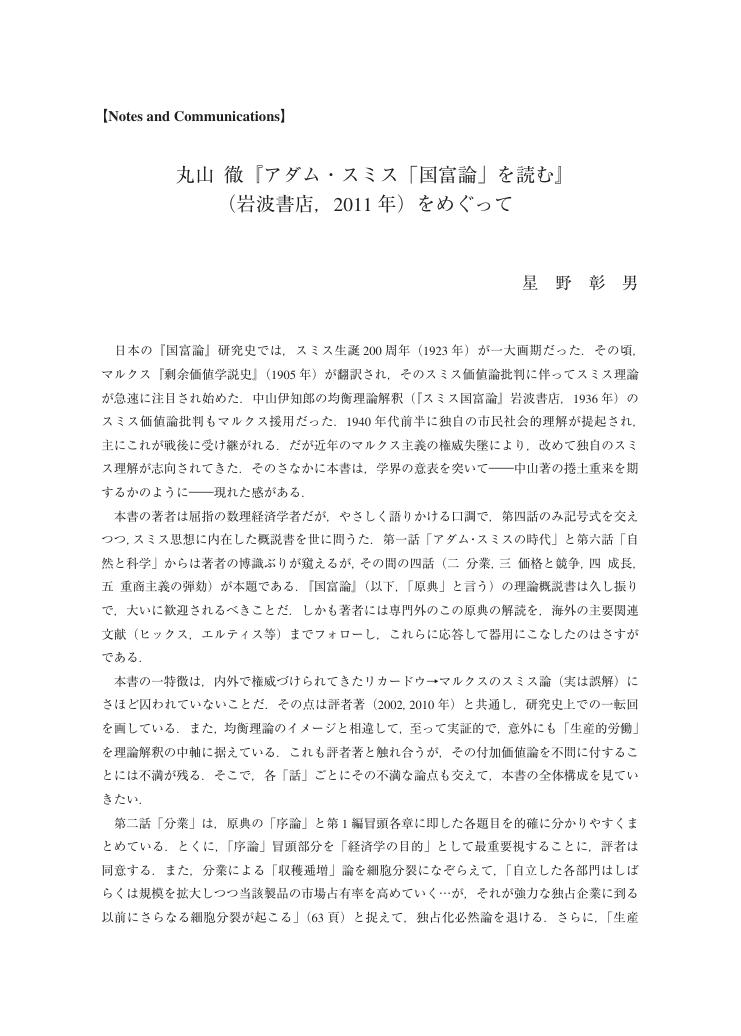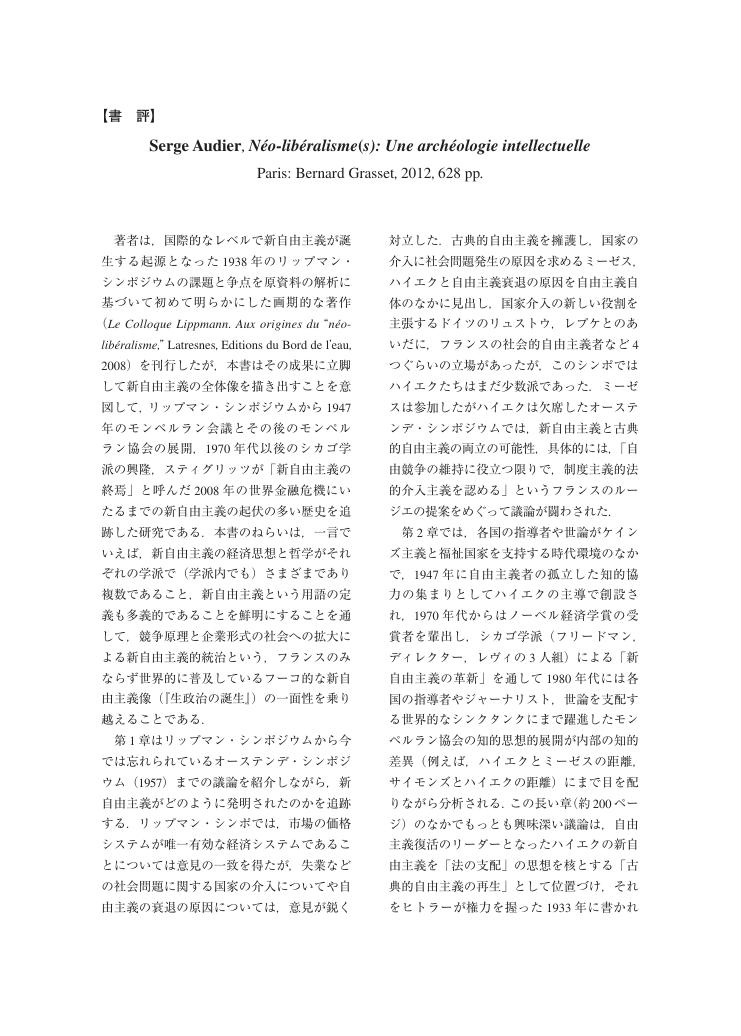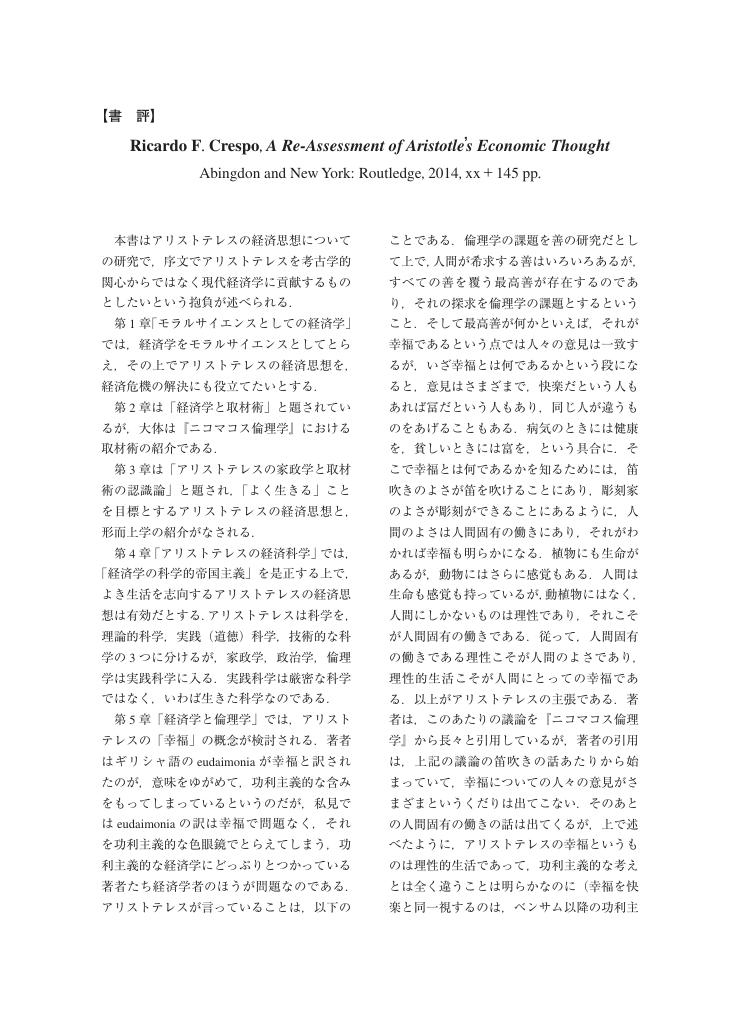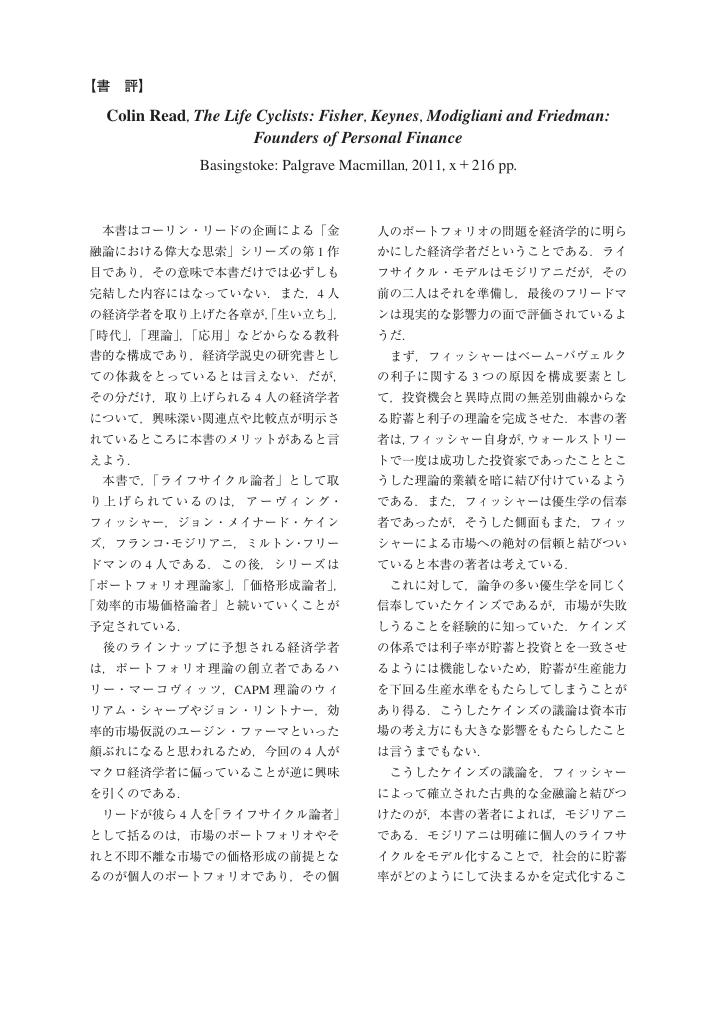- 著者
- 梅津 順一
- 出版者
- 経済学史学会
- 雑誌
- 経済学史研究 (ISSN:18803164)
- 巻号頁・発行日
- vol.56, no.2, pp.146-147, 2015 (Released:2019-11-30)
1 0 0 0 OA 中山智香子『経済ジェノサイド――フリードマンと世界経済の半世紀』平凡社,2013年,296頁/服部茂幸『新自由主義の帰結――なぜ世界経済は停滞するのか』岩波新書,2013年,224頁
- 著者
- 橋本 努
- 出版者
- 経済学史学会
- 雑誌
- 経済学史研究 (ISSN:18803164)
- 巻号頁・発行日
- vol.56, no.2, pp.148-149, 2015 (Released:2019-11-30)
1 0 0 0 OA 丸山徹『アダム・スミス「国富論」を読む』(岩波書店,2011年)をめぐって
- 著者
- 星野 彰男
- 出版者
- 経済学史学会
- 雑誌
- 経済学史研究 (ISSN:18803164)
- 巻号頁・発行日
- vol.56, no.2, pp.113-116, 2015 (Released:2019-08-26)
- 著者
- 若森 章孝
- 出版者
- 経済学史学会
- 雑誌
- 経済学史研究 (ISSN:18803164)
- 巻号頁・発行日
- vol.56, no.2, pp.125-126, 2015 (Released:2019-11-30)
- 著者
- 森岡 邦泰
- 出版者
- 経済学史学会
- 雑誌
- 経済学史研究 (ISSN:18803164)
- 巻号頁・発行日
- vol.56, no.2, pp.127-128, 2015 (Released:2019-11-30)
- 著者
- 高草木 光一
- 出版者
- 経済学史学会
- 雑誌
- 経済学史研究 (ISSN:18803164)
- 巻号頁・発行日
- vol.56, no.2, pp.131-132, 2015 (Released:2019-11-30)
1 0 0 0 OA 西沢保・小峯敦編著『創設期の厚生経済学と福祉国家』 ミネルヴァ書房, 2013
- 著者
- 藤田 菜々子
- 出版者
- 経済学史学会
- 雑誌
- 経済学史研究 (ISSN:18803164)
- 巻号頁・発行日
- vol.56, no.1, pp.149-150, 2014 (Released:2019-08-24)
- 著者
- 水田 洋
- 出版者
- 経済学史学会
- 雑誌
- 経済学史研究 (ISSN:18803164)
- 巻号頁・発行日
- vol.56, no.1, pp.151-153, 2014 (Released:2019-08-24)
- 著者
- 西部 忠
- 出版者
- 経済学史学会
- 雑誌
- 経済学史研究 (ISSN:18803164)
- 巻号頁・発行日
- vol.56, no.1, pp.154-156, 2014 (Released:2019-08-24)
- 著者
- 伊藤 誠一郎
- 出版者
- 経済学史学会
- 雑誌
- 経済学史研究 (ISSN:18803164)
- 巻号頁・発行日
- vol.56, no.1, pp.157-159, 2014 (Released:2019-08-24)
1 0 0 0 OA マーシャルにおける組織 生産の経済学の観点からの再評価
- 著者
- 藤井 賢二
- 出版者
- 経済学史学会
- 雑誌
- 経済学史研究 (ISSN:18803164)
- 巻号頁・発行日
- vol.56, no.2, pp.28-46, 2015 (Released:2019-08-26)
Abstract: Marshallsʼ economics has long been regarded as an abbreviated version of general equilibri-um theory by most students and scholars of economics. Despite the fact that those scholars of history of economic thought called as post-Marshallians have endeavored to show the text-book interpretation fails to capture the dynamic aspects of Marshallʼs economics, their ap-peals havenʼt been recognized even in a circle of historians of economic thoughts. Much needs to be done to rectify the present situation. We contend in this paper that the existence and role of firms in Marshallʼs economics is starkly different from those based on transac-tion-cost theory, which has been recognized as an applied and extended version of the stand-ard exchange theory. Whereas firms are interpreted as a cost-saving tool in transaction-cost theory, firms in Marshallʼs economics must be interpreted differently from the angle of plu-tology which means the economics of production. Their main functions are integration and coordination of production knowledge, through which firms become a sort of knowledge community. Firms cannot survive if they remain merely as a collection of production factors. For a firm to function as a knowledge community, Marshall thought that it also had to be a profit-sharing community of principal members of it at least. Marshallʼs view of firms has much in common with modern dynamic capabilities and resource-based approaches. JEL classification numbers: B13, B31.
- 著者
- 山崎 好裕
- 出版者
- 経済学史学会
- 雑誌
- 経済学史研究 (ISSN:18803164)
- 巻号頁・発行日
- vol.56, no.1, pp.129-130, 2014 (Released:2019-08-24)
- 著者
- 中川 栄治
- 出版者
- 経済学史学会
- 雑誌
- 経済学史研究 (ISSN:18803164)
- 巻号頁・発行日
- vol.56, no.1, pp.132-134, 2014 (Released:2019-08-24)
- 著者
- 石田 教子
- 出版者
- 経済学史学会
- 雑誌
- 経済学史研究 (ISSN:18803164)
- 巻号頁・発行日
- vol.56, no.1, pp.135-137, 2014 (Released:2019-08-24)
1 0 0 0 OA Liana Vardi, The Physiocrats and the World of the Enlightenment Cambridge University Press, 2012
- 著者
- 米田 昇平
- 出版者
- 経済学史学会
- 雑誌
- 経済学史研究 (ISSN:18803164)
- 巻号頁・発行日
- vol.56, no.1, pp.138-140, 2014 (Released:2019-08-24)
1 0 0 0 OA 井上義朗『二つの「競争」――競争観をめぐる現代経済思想』 講談社現代新書, 2012
- 著者
- 伊藤 宣広
- 出版者
- 経済学史学会
- 雑誌
- 経済学史研究 (ISSN:18803164)
- 巻号頁・発行日
- vol.56, no.1, pp.141, 2014 (Released:2019-08-24)
1 0 0 0 OA 佐々木憲介『イギリス歴史学派と経済学方法論争』 北海道大学出版会, 2013
- 著者
- 上宮 正一郎
- 出版者
- 経済学史学会
- 雑誌
- 経済学史研究 (ISSN:18803164)
- 巻号頁・発行日
- vol.56, no.1, pp.144-146, 2014 (Released:2019-08-24)
1 0 0 0 OA 田中正司『アダム・スミスの認識論管見』 社会評論社, 2013
- 著者
- 星野 彰男
- 出版者
- 経済学史学会
- 雑誌
- 経済学史研究 (ISSN:18803164)
- 巻号頁・発行日
- vol.56, no.1, pp.147-148, 2014 (Released:2019-08-24)
1 0 0 0 OA 柴田敬によるベーム-バヴェルク理論の一般化の試み 生産構造の問題を中心として
- 著者
- 西 淳
- 出版者
- 経済学史学会
- 雑誌
- 経済学史研究 (ISSN:18803164)
- 巻号頁・発行日
- vol.56, no.1, pp.48-70, 2014 (Released:2019-08-24)
Abstract: Kei Shibata (1902―1986), a creative theoretical economist, was the first Japanese economist to gain international recognition. One of his most famous works is an attempt to synthesize Walrasian/Casselian General Equilibrium Theory with Marxian Economic Theory. Most of his economic theories were first published in Keizaironso and were later included in his first book, Rironkeizaigaku (meaning theoretical economics) published in 1935 and 1936. After completing this book, Shibata turned to investigating new economic principles be-yond capitalism. Shibataʼs investigation had some byproducts. The most remarkable was an attempt to generalize Böhm-Bawerkʼs concept of the average period of production (APP), which is defined as the length of the roundabout production process, whereby capital goods are first produced and then employed in the production of the final consumer good. This con-cept was criticized because it can only be applied in the case of a single linear stage pattern of production, but not in the case of an autoregressive pattern of input―output structure. Later studies reveal that the concept is destined to fail because as the roundabout period of produc-tion reaches an infinite value, the APP also reaches an infinite value. However, Shibata presented a mathematical way of determining the APP using an autoregressive pattern of the input―output structure. In addition, he concluded that in such cases, the APP has a finite value. His investigation is connected to the concept of the so-called capital intensity in modern economics and the organic composition of capital in Marx-ian economics. Therefore, his findings require further research. Hence, the present study aims to re-examine Shibataʼs contribution to the generalization of Böhm-Bawerkʼs theory of the APP. JEL classification numbers: B 41, B 53, D 24.
1 0 0 0 OA カンティロンとチュルゴ― 古典派的利潤論の形成における企業者概念の意義
- 著者
- 金子 創
- 出版者
- 経済学史学会
- 雑誌
- 経済学史研究 (ISSN:18803164)
- 巻号頁・発行日
- vol.56, no.1, pp.71-88, 2014 (Released:2019-08-24)
Abstract: This study focuses on Richard Cantillonʼs and Anne Robert Jacques Turgotʼs theories of the entrepreneur in order to revisit the conceptual structure of classical economic thought found-ed by Adam Smith. The frameworks of the classical concept of profit, assumed by Cantillon and Turgot are each examined to determine the following four issues: (a) whether a surplus of income over a given subsistence consumption level is distributed to an agent and whether it is saved accordingly; (b) whether and under what kinds of opportunity savings are invest-ed; (c) whether capital accumulation is attained as a consequence of investment; and (d) whether and how a surplus is accrued. Cantillon made four key assumptions in his work. First, he assumed that even if a sur-plus is distributed to an entrepreneur, it is not always saved. Secondly, whenever a surplus is saved, the savings are used only to buy land. Next, because savings are used only for land purchases, capital accumulation is hardly attained. Lastly, the surplus accrued by an entrepre-neur is due to his risk-taking behavior. By contrast, Turgot assumed that an entrepreneur normally saves the surplus that is dis-tributed to him, and that saving is not only used to buy land, but also used for productive in-vestment. He also assumed that because of this productive investment, capital accumulation can be achieved and that an entrepreneur could accrue a surplus from his risk-bearing, provi-sion of advanced labor service, or investment. This research, which takes into consideration each of their assumptions on the long-run state, provides a precise comparison between their frameworks of analysis of the entrepre-neur. Furthermore, this comparison makes it possible to explain that the foundation of the classical framework was related to a change in the assumptions on the behavior of an eco-nomic agent. JEL classification numbers: B 11, B 12.
















